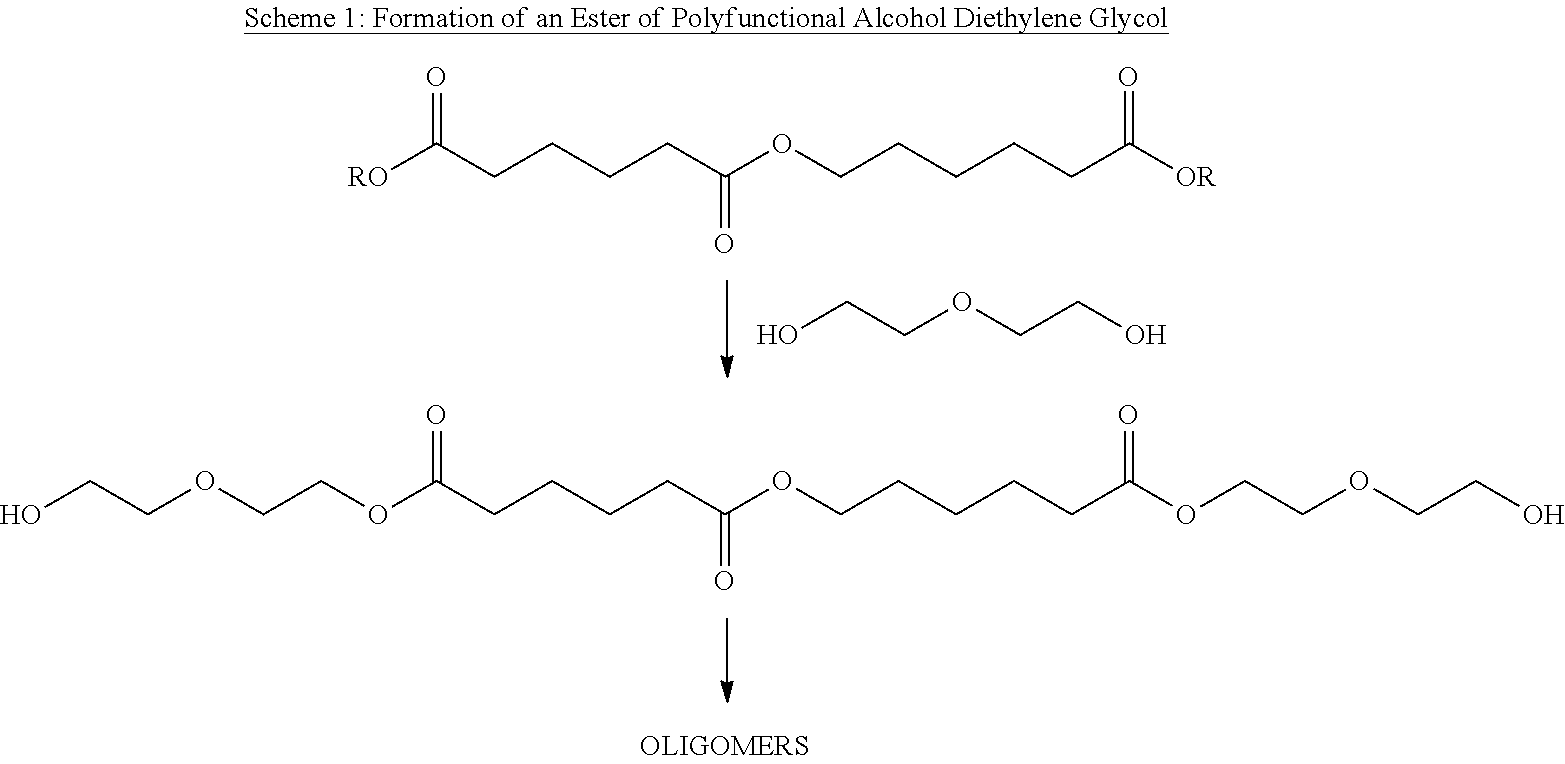Aliphatic polyester polyols from cyclohexane oxidation byproduct streams as precursors for polyurethane and polyisocyanurate polymers
a technology of cyclohexane oxidation and byproducts, which is applied in the direction of polyurea/polyurethane coatings, fertilizer mixtures, polyurea/polyurethane coatings, etc., can solve the problems of inability to fully utilize the byproduct stream from adipic acid manufacture, difficult and/or costly purification, and inability to use directly, etc., to achieve better timed or controlled release fertilizer compositions, prolonging
- Summary
- Abstract
- Description
- Claims
- Application Information
AI Technical Summary
Benefits of technology
Problems solved by technology
Method used
Image
Examples
example 1
[0213]This example describes use of NVR-based polyol of the current invention to prepare a coated urea according to procedure A described above.
[0214]A 1-liter pear-shaped Büchi rotary-evaporator flask was charged with 150 g urea prills (Aldrich catalog number 51460, 99.0% purity). Solution B is prepared comprising 4.20 g polyol of Polyol Example 1 and 0.49 g triethanolamine in dry toluene to make a total of 42 g. Solution A is prepared comprising 3.34 g polymeric methylene diphenyl diisocyanate (Sigma Aldrich product number 372986, 30% NCO) in dry toluene to make a total of 42 g. The amounts of polyol and isocyanate are calculated to give a combined weight of polyol, triethanolamine, and isocyanate of 8 grams and an isocyanate index of 1.05. Solution A and solution B are each divided into 6 equal portions. One sixth of solution A is combined with one sixth of solution B and the combined solution is immediately admitted to the coating apparatus as described abo...
example 2
[0216]This example describes use of NVR-based polyol of the current invention to prepare a coated urea using procedure B described above.
[0217]A 1-liter pear-shaped Büchi rotary-evaporator flask was charged with 150 g granulated urea (Lange-Stegmann Company, St. Louis, Mo.). Solution B is prepared comprising 3.86 g polyol of Polyol Example 1 and 0.49 g triethanolamine in dry toluene to make a total of 12 g. Solution A is prepared comprising 3.15 g polymeric methylene diphenyl diisocyanate (Sigma Aldrich product number 372986, 30% NCO) in dry toluene to make a total of 12 g. The amounts of polyol and isocyanate are calculated to give a combined weight of polyol, triethanolamine, and isocyanate of 7.5 grams and an isocyanate index of 1.05. Solution A and solution B are each divided into 6 equal portions. One sixth of solution A is combined with one sixth of solution B and the combined solution is immediately added to the coating flask as described in procedure B ...
example 3
[0219]This example describes use of NVR-based polyol of the current invention to prepare a coated urea using procedure B described above.
[0220]A 1-liter pear-shaped Büchi rotary-evaporator flask was charged with 150 g granular urea (Lange-Stegmann Company, St. Louis, Mo.). Solution B is prepared by dissolving 3.86 g polyol of Polyol Example 1 and 0.49 g triethanolamine in dry toluene to make a total of 6 g. Solution A is prepared by dissolving 3.15 g polymeric methylene diphenyl diisocyanate (Sigma Aldrich product number 372986, 30% NCO) in dry toluene to make a total of 6 g. The amounts of polyol and isocyanate are calculated to give a combined weight of polyol, triethanolamine, and isocyanate of 7.5 grams and an isocyanate index of 1.05. Solution A and solution B are each divided into 6 equal portions. One sixth of solution A is combined with one sixth of solution B and the combined solution is immediately added directly to the evaporator flask as described i...
PUM
| Property | Measurement | Unit |
|---|---|---|
| Fraction | aaaaa | aaaaa |
| Fraction | aaaaa | aaaaa |
| Fraction | aaaaa | aaaaa |
Abstract
Description
Claims
Application Information
 Login to View More
Login to View More - R&D
- Intellectual Property
- Life Sciences
- Materials
- Tech Scout
- Unparalleled Data Quality
- Higher Quality Content
- 60% Fewer Hallucinations
Browse by: Latest US Patents, China's latest patents, Technical Efficacy Thesaurus, Application Domain, Technology Topic, Popular Technical Reports.
© 2025 PatSnap. All rights reserved.Legal|Privacy policy|Modern Slavery Act Transparency Statement|Sitemap|About US| Contact US: help@patsnap.com



